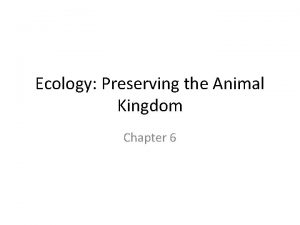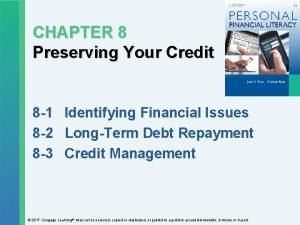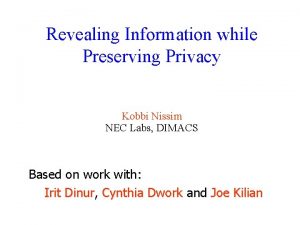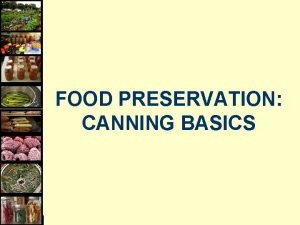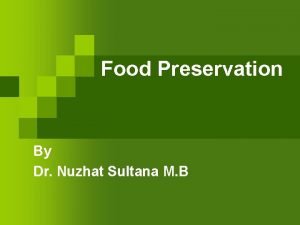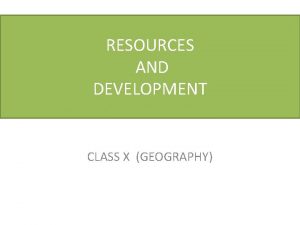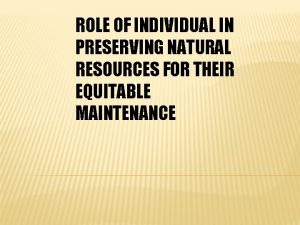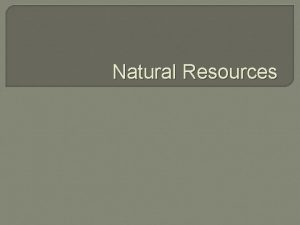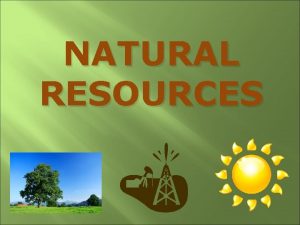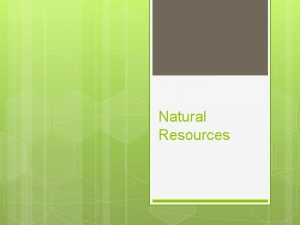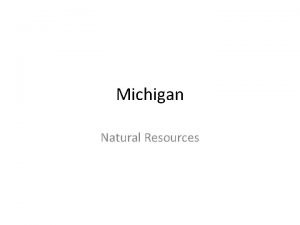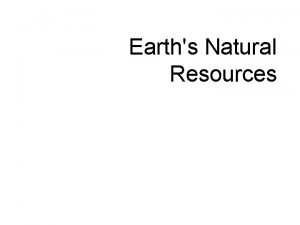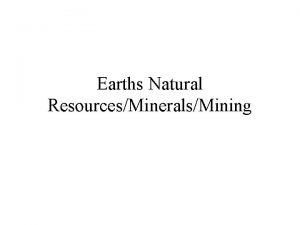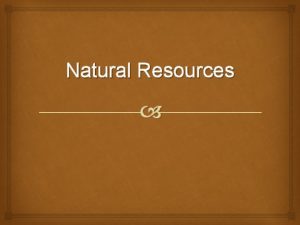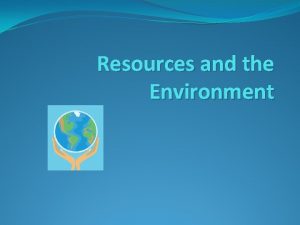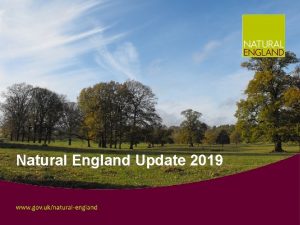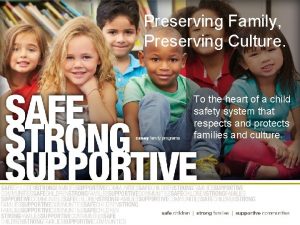ROLE OF INDIVIDUAL IN PRESERVING NATURAL RESOURCES FOR
















- Slides: 16

ROLE OF INDIVIDUAL IN PRESERVING NATURAL RESOURCES FOR THEIR EQUITABLE MAINTENANCE

NATURAL RESOURCES � � Natural resources occur naturally within environments that exist relatively undisturbed by mankind, in a natural form. Some of them are essential for our survival while most are used for satisfying our wants. They are present abundantly in nature. Natural resources are materials and components that can be found within the environment. Every man-made product is composed of natural resources. A natural resource may exist as a separate entity such as fresh water, and air, as well as a living organism such as a fish, or it may exist in an alternate form which must be processed to obtain the resource such as metal ores, oil, and most forms of energy.

CLASSIFICATION OF NATURAL RESOURCES BASED ON ORIGIN � Based on their origin, natural resources are classified into 1)Biotic: Biotic resources are obtained from the biosphere (living and organic material), such as forests, animals, birds, and fish and the materials that can be obtained from them. Fossil fuels such as coal and petroleum are also included in this category because they are formed from decayed organic matter. 2)Abiotic: Abiotic resources are those that come from non-living, non-organic material. Examples of abiotic resources include land, fresh water, air and heavy metals including ores such as gold, iron, copper, silver, etc.

CLASSIFICATION OF NATURAL RESOURCES BASED ON AVAILABILITY � Based on their availability natural resources are classified into 1)Renewable Resources: Renewable resources are ones that can be replenished naturally. Some of these resources, like sunlight, air, wind, etc. , are continuously available and their quantity is noticeably affected by human consumption. Though many renewable resources do not have such a rapid recovery rate, these resources are susceptible to depletion by over-use. Resources from a human use perspective are classified as renewable only so long as the rate of replenishment/recovery exceeds that of the rate of consumption. 2)Non Renewable Resources: Non-renewable resources are resources that form extremely slowly and those that do not naturally form in the environment. Minerals are the most common resource included in this category. By the human perspective, resources are non-renewable when their rate of consumption exceeds the rate of replenishment/recovery; a good example of this are fossil fuels, which are in this category because their rate of formation is extremely slow (potentially millions of years), meaning they are considered non-renewable. Some resources actually naturally deplete in amount without human interference, the most notable of these being radioactive elements such as uranium, which naturally decay into heavy metals. Of these, the metallic minerals can be re-used by recycling them, but coal and petroleum cannot be recycled.

BASIC NATURAL RESOUCES � � � Forest Resources Water Resources Mineral Resources Food Resources Land Resources Energy Resources

MEASURES TO PRESERVE NATURAL RESOURCES

CONSERVATION OF FOREST RESOURCES DEFORESTATION: Deforestation is the clearing of natural forests by logging or burning of trees and plants in a forested area. As a result of deforestation, presently about one half of the forests that once covered the Earth have been destroyed. It occurs for many different reasons, and it has several negative implications on the atmosphere and the quality of the land in and surrounding the forest.

CONTROL MEASURES OF DEFORESTATION � � � � We should not cut trees rapidly. We should use trees in smaller quantity. Whenever we cut a tree , we should plant a new tree to make the nature in balance. We should not burn poly bags , because it produces a lot of smoke and carbon -dioxide. The government of a state should ensure that there should be less and less forest fires and the people living near the area should be careful. The media can play an important role, by creating awareness. Prevent construction of too many dams. Reduce mining activity.

CONSERVATION OF WATER RESOURCES � � � � Use less water. Use environmentally-friendly household products. Apply natural pesticides and fertilizers. Don’t litter. Dispose off toxic products with care. Prevent dumping of e-wastes and plastic wastes. Stop over-utilisation and over-exploitation of water. Adopt water harvesting.

CONTROL MEASURES OF MINING � � � � � Reducing the consumption of minerals. The efficiency of manufacturing processes can be increased to reduce the amount of new minerals required. Substitution of other materials and processes with more environmentally friendly materials and processes. Using recycled materials instead of mined materials. Improving environmental performance at mines. Legislation and regulations to reduce environmental impacts can be enacted and enforced. Cleaning up abandoned mine sites. Economic measures like tax shifting, can be introduced to provide incentives for practices like product substitution and disincentives for poor environmental performance. Biomining or bioleaching.

PREVENTIVE MEASURES OF MODERN METHODS OF CULTIVATION � � � � Green Revolution introduced by Norman Borlang. Organic farming is the combination of traditional farming practices with modern techniques Mulching: Layering or adding dry leaves, soil and water which increases the soil fertility. Composting: Conversion of complex materials into simpler forms by the aid of micro organisms. Crop rotation: Leguminous plants are planted to add nutrients to soil and avoid pesticides. Terrace/Contour farming: To avoid water problems and soil erosion, we develop small trenches near the plant so that water stays near the plant.

MEASURES TO PREVENT SOIL EROSION AND MAN INDUCED EARTHQUAKES � � � � Prevent soil erosion by planting vegetation, trees, ground cover, shrubs and other plants. Roots from these plants will help hold soil in place on the ground. Soil will not blow away due to wind, or be washed away from rain as easily. Create windbreaks, which are barrier rows planted along the windward exposure of a plot of land. Windbreaks made out of trees, such as evergreen trees or bushes help prevent erosion by preventing wind from blowing across your land. Grow cover crops on farm land. When land is not being used during the off season, cover crops can help prevent soil erosion due to wind and rain. Legumes (beans) are often used as cover crops. Apply mulch to retain moisture and also help prevent soil erosion. Topsoil is not as likely to be washed or blown away when it is covered by mulch. Mulch is often used in flower beds. Construct surface runoff barriers, such as edging made of bricks or stones, can help prevent soil erosion by minimizing runoff. If runoff is minimized, soil is less likely to be carried away by groundwater runoff. Use contour farming when farming on sloped areas. This conservation technique is to follow the actual topography of a slope when planting crops. Using the natural lay of the land in this way can also prevent soil erosion. Try terrace farming and gardening to decrease groundwater runoff. Create nearly level layers of crops on a hillside.

MEASURES TO CONSERVE ENERGY � � � Do not leave your Air Conditioner on while you are out or it is simply not needed. In fact it is estimated that your Air Conditioner wastes about $0. 25 worth of energy in one hour. A simple thing as a light switch can effect your consumption rate. Buy a dimmer, which allows you to select the brightness of your light. Which can help you use less of energy but not turning the light bulb on all the way. Purchase fluorescent light bulbs. They not only are brighter, but they also last up to 10 times longer then a usual bulb while consuming a quarter of the power. Insulate your windows. Heat can easily escape your home through cracks and opening in walls and windows. Spending some cash insulating, can lead to huge savings in the long run. Turn your appliances, especially the computer off when you are not using it. Waiting 5 minuets for it to turn on beats the enormous amount of money that you will save on your bill at the end of the month.

CONCLUSION � � The environment we live in is a beautiful place. Let us not pollute it for our selfish needs. It is our responsibility to give the next generation a better, hygienic future and to preserve energy for future use. It is high time to take a step forward to curb the environmental pollution and make it a place suitable for better standards of living. It is imperative on our part to save our environment


GNANA TEJA ECE-A
 Ecology preserving the animal kingdom
Ecology preserving the animal kingdom Preserving your credit
Preserving your credit Preserving your credit
Preserving your credit âq1
âq1 Example of an orthogonal matrix
Example of an orthogonal matrix Preserving statistical validity in adaptive data analysis
Preserving statistical validity in adaptive data analysis Structure-preserving neural style transfer
Structure-preserving neural style transfer Preserving food
Preserving food Dr nuzhat sultana
Dr nuzhat sultana Individual resources
Individual resources Transformation process in operations management
Transformation process in operations management Fixed and variable resources
Fixed and variable resources Renewable resources vs nonrenewable resources
Renewable resources vs nonrenewable resources The role of psychology in human resources management
The role of psychology in human resources management Azure worker role
Azure worker role Role taking krappmann
Role taking krappmann Role conflict occurs when fulfilling the role expectations
Role conflict occurs when fulfilling the role expectations
